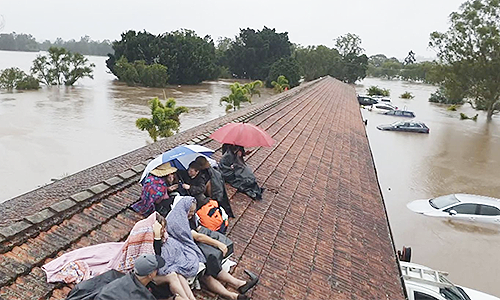
THERE’S nothing like a war and a flood to ease pretend problems like exaggerated viral outbreaks off the front pages.
Suddenly Australians have heard of Lismore and Kyiv. (With apologies to Jerry Seinfeld, it will always be Kiev to me).
- This is Lismore, where the town’s name and “floods” routinely appear in the same sentence.
- Yes, there really are dead cows, canoes, pallets of timber, to name but a few disparate items on roofs.
- The heroism is anything but clichéd, as are the many random acts of kindness.
COVID? What is that? The endlessly newsworthy, tedious virus was shoved back into its box this week, and placed in its proper perspective.
This was my first experience of a Lismore flood. Just about every street in town has telegraph poles with markers showing where the 1974 floods reached.
FLOODS
These indicators provide intel – or so everyone thought – on all sorts of things, like where to buy and not buy houses and where it is “safe” to leave cars during floods.
I saw a cricket field downtown under water at lunchtime Sunday. Noteworthy but not (I assumed) alarming.
It pelted rain all day Sunday and into the night, following days of on-again, off-again downpours.
The place was already soaked. But no one seemed overly concerned. To report that no one really saw this coming is both accurate yet (on reflection) unbelievable. Really?
This is Lismore, where the town’s name and “floods” do routinely appear in the same sentence.
By dawn on Monday, the floodwaters were, suddenly, creeping relentlessly up our “flood-free” (1974) street.
Cars were disappearing underwater. Concerning. Near-neighbours’ houses suddenly had water lapping at their doors, then their windows. And the rain still poured down.
The week has seen both heroism and clichés. Disasters always do.
The NSW Premier’s “one-in-a-thousand-year flood event” would be a contender for the worst cliché.
“Unprecedented”, inevitably, has had a good run. And a ministry of resilience? Of course!
But the heroism is anything but clichéd, as are the many random acts of kindness.
I witnessed but one of the thirty or so pop-up evacuation centres across town.
Normally an indoor swimming and recreation centre, up on the hill in suburban, relatively dry and still-powered Goonellebah.
CRISIS
The worn-out volunteers here were providing tea and coffee, donated hot meals, showers, links to medical service providers and, in this twenty-first century crisis, the most precious commodity of all – the charging of phones.
I met one man who had been rescued by volunteers in the middle of Sunday night. With nothing left. No possessions, bits of his home missing, neighbours deceased.
With literally only the clothes on his back. His family are staying with friends. His old dog, who hates water and boats (!) is safe if discombobulated after a stressful rescue.
The blame game was on even as the bodies – likely to be significantly under-reported – were being recovered.
The general manager of Kyogle Shire had a go at Telstra. The freshly minted Mayor of Lismore, unusually a businessman in this green-Left-rainbow town, was elected in the spring with an astounding majority and a back-to-basics agenda, had cause to upbraid the State Emergency Services performance in the crisis.
Only two boats? In Lismore? Seems like a good question for the NSW Emergency Service Minister.
I did hear that unvaccinated SES people were prevented from joining in the rescue operations.
Surely a wind-up by a conspiracy theorist? What is fact is that the Lismore head of the SES was on Facebook telling volunteers to keep away from rescue efforts because the SES people had just completed “months of training”.
What if those persistent volunteers hadn’t ignored this corporatist rubbish and had not struggled on? They simply got on with it, through the darkness and terrifying waters.
For two days our flooded street resembled a marina with volunteers launching their tinnies, a scene replicated on any number of Lismore streets.
I surmise that the death toll would have been immeasurably higher had the SES instructions been heeded. And that would not have been good news for the official rescue family and their political masters.
DREADFUL
The recovery operation had been going for days. I think that city-based media types were, by Friday and prompted by the appearance of dreadful aerial photos of the town, finally beginning to realise that we had our own Kyiv in Australia.
Yes, there really are dead cows, canoes, pallets of timber, to name but a few disparate items on roofs.
One friend had a dead donkey lodged at the back door. The tales of looters on the move – on Sunday night!
Downtown businesses with bits of their buildings missing. The ever-present whirring of Black Hawk choppers.
The utter black darkness of the nights. The fact that follow-on rains are actually welcomed to help soften the mud for the gurneys to work (if you’re lucky enough to have power to make use of one).
The water restrictions. The stench. The shortage of earth moving equipment.
Having escaped the waters, I now understand something of survivor’s guilt. We got lucky.
We even have the power back, five days on. We are watching television tonight.
The submerged have no such relief, or luck. They are still dealing with mud and putrid slush and destroyed dreams.
They face an age of pain, so slow are the processes of recovery and insurance claims. And for many, joblessness.
No businesses in town to work in any more. No cathedral for local Catholics to pray in, merely floating pews to be seen at the centre of worship.
SECULAR
No other churches available either. They are all located in and around the CBD. With the twin secular cathedrals – McDonalds and Bunnings – both hit, respectively, by the absence of stock and by floodwaters, hence closed as well, all hope seemed gone.
What a week to take Neighbours off the air.
Where on earth will we get tradesmen to work on homes and businesses smashed beyond repair?
I know of tradies who have lost all their tools. Their vans. The Mayor of Lismore lost his own downtown home and (café) business.
Keeping up a brave front, communicating hope and lobbying for help in a focussed way must be very, very difficult.
The work done by Essential Energy has been monumental. The catastrophe has hit all the way up and down the North Coast.
Roads and bridges have disappeared altogether. Many properties simply cannot be reached. Just ask all the poor anti-vaxxers of Mullumbimby, coping now with a horrendous mudslide after two years of abuse and derision.
Lismore faces awful prospects in the short term and likely beyond. The mall apparently was not built to cope with a flood that reached to the ceilings of the elevated shopping level above the car park. Bad idea.
No Lismore Square for probably at least a year. Given the destruction of downtown there won’t be much retail joy (essential or otherwise) for the foreseeable future.
Normally, you would have expected ScoMo to have landed in Lismore by now. But, no.
Perhaps he was suitably chastised by his less-than-tumultuous welcome in Cobargo during the fires.
COMBAT
It might be wise to stay away. After all, he has a real crisis on his hands with the recalcitrant NSW Liberal Party with whom he is in mortal combat.
Mercifully, we have in Canberra Senator Bridget McKenzie, no less, in charge of the disaster recovery. Is there a gun club in Lismore needing a grant?
Perhaps the good senator might consider more innovative ideas rather than just the normal grants. Perhaps she could motivate Telstra to get pop-up mobile phone towers in situ.
Get generators sourced and distributed. And fuelled. Supply gurneys that are needed to get the festy rubbish out of homes and the power businesses need to work.
Faster street cleaning to clear the streets. Try harder to get fuel delivered, so the scenes of cars literally following fuel trucks around cease.
Darwin in 1974 had its coordinator (Major-General Alan Stretton). Maybe one for Lismore and surrounds?
Oh no, Senator Bridget is busying herself with talking to the ABC … about climate change!
Governments have spent two years “doing things” when they should have done nothing.
Ruining our lives, relentlessly, without cease. Now, when we need a bit of big and smart, coordinating government on the ground, where the hell are they?
There lingers the suspicion that there is lacking at the top the remotest sense of practical problem-solving in the face of real crises, while those same, cossetted panjandrums forever pontificate about problems that only they perceive.
CRUSHED
Meantime, the folks on the ground (we-the-people) save lives, man boats, pull pets and old and young alike from rooftops and out of surging waters, provide warm beds, comfort the crushed, find generators, charge phones.
The NSW Premier is “reviewing” the response from Sydney to the plight of those now stranded – still – without homes, businesses, food, fuel, medical supplies, power, the ability to communicate and, for many, hope. As well he might.
And the NSW Police Minister might have a quiet word with the copper photographed pointing his speed camera at motorists outside mud-struck Mullumbimby. Not a good look, officer.PC













Thank you again for telling what happened in Lismore, Paul. I don’t want to go into Lismore and see the mess and ghost town it now is. One thing is sure, people didn’t realize what was coming as there was no cyclone, wind or storm just a lot of rain over the catchments areas. Beforehand, the Council and Rous Water were talking about the need for a new dam but I don’t think Lismore residents would like to hear that Lismore CBD would make a good one.
Floods, for several years after I retired I lived on the Queensland Fraser Coast, when I was renovating and extending my house there an earth auger digging holes for timber piers dug up round river pebbles and other material that indicated that there had been a creek where my house was since it was built in the early 1930s.
When I purchased it I obtained flood records from the Council and carefully highlighted where the highest flood level recorded had reached, and that was some distance from my property. Therefore, with due consideration for the old creek, it is possible that in past decades flooding had reached my property.
I discussed this with friends who had lived there all of their lives including a relation of the original owner of my property and none of them were aware of floods reaching it. But about five years later neighbours across the road on a slightly higher level and properties behind them were damaged during unusually heavy rain by flash flooding that followed the hidden old creek bed. They had topsoil washed away from their lawns which later died and had to be top dressed and replanted.
So we mere mortals cannot pretend to have all of the answers and we must deal with nature as events take place, and we cannot simply blame politicians and/or public service employees.
Why does the Prime Minister always cop blame for matters the Federal Government has no direct responsibility for dealing with, natural disasters are State Government and services area of responsibility and funded from State Government Budgets.
Same applies to the NSW 2019 bushfires, State Emergency Services, State Rural Fire Service, and the others.
And when a Prime Minister or a Premier is away the Deputy takes over as Acting PM/Premier with other Cabinet Ministers also on duty. When the PM was relentlessly attacked for being on holidays there was one Premier and a couple of State Cabinet Ministers also on leave at that time.
Constructing flood protection levies, building bridges and roads above floodwater height (impossible to provide a guarantee) and approval of building and construction Development Applications are all State and Local Council responsibility.
Same goes for all development approvals, mining, dams, power stations, roads, bridges, and others.
The new gas fired power generator now being built in the NSW Hunter Valley was one of four proposed for Victoria, New South Wales and Queensland by the Federal Government, Hunter Valley the only one approved to date. Federal Government also proposed a new coal fired HELE power station for North Queensland and offered to underwrite the financing, that too has not yet been approved by the Queensland State Government.
Federal assistance is mostly funding grants as applied for and deployment of ADF resources as and when requested by State authorities. According to reports when inquiries were made about ADF preparing for deployment the State authorities, not only in NSW, rejected the suggestion. Apparently this was a senior employee executive decision and suspected of being a backside covering exercise (we are of course well prepared) and based on BoM weather forecasts not providing early warning about the very heavy rainfall event about to begin.
The Lismore District Mayor spoke on radio recently and discussed previous floods and the location of the shopping centre and nearby houses spanning back many decades and experiencing many flood events. And that in more recent times many new houses have been built on higher ground. He also acknowledged the local volunteers and the flood barriers that slowed the arrival time for outside assistance. The ADF did provide helicopters quickly but airfields were flooded. And the ADF could not deploy personnel and equipment while roads and bridges were cut or before accommodation tents, food supplies and fuel supplies were ready for delivery to support them.
I also suspect that flood victims, and I do sincerely feel sorry for them and the situation they are now suffering, tend to forget that the flooding is in many different areas and states, as they understandably focus on their own experiences.
Some are calling for a permanent disaster organisation, like a Federal Emergency Services, but the costs would be enormous and like Labor’s Coastguard proposal of the past that ignored Navy and Customs patrols and other surveillance including by air and the RAAF Jindalee Over The Horizon Radar Network and others, ADF Norforce and since Abbott Government 2014 now including Border Force.
There is a limit to what politicians and other public service employees can do to protect us from natural disasters, they are no climate emergencies, they are natural weather events, and have taken place many times since white settlement in 1788 and way back earlier in the history of our land, the land of droughts and flooding rains.